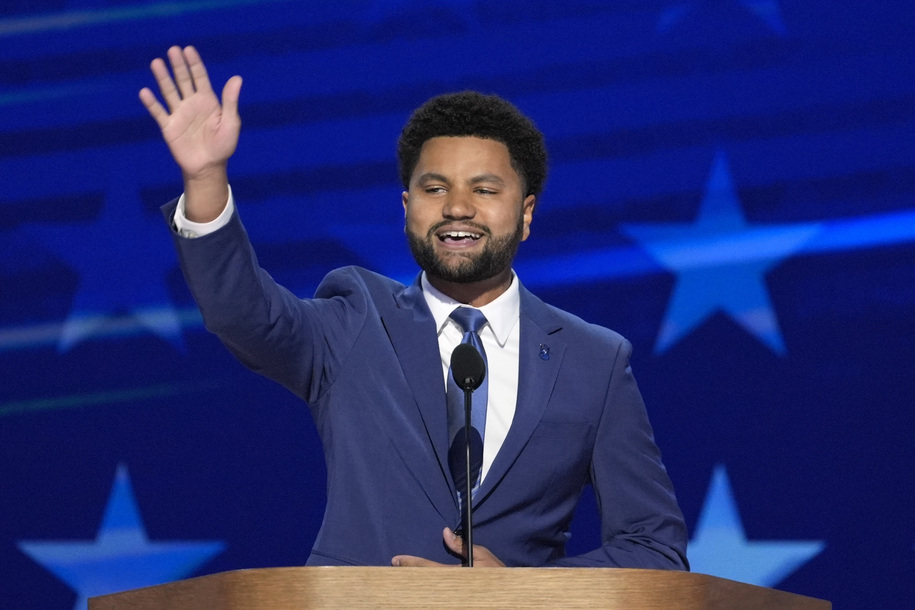The 2024 presidential campaign wasn’t just the strangest campaign our country has ever seen, it was also the most expensive political operation in history. That has pro-democracy advocates concerned about how the soaring cost of campaigning is pricing young people out of running for office entirely.
This year’s numbers are a sight to behold. President-elect Donald Trump and Vice President Kamala Harris spent a combined $5.5 billion on their presidential races, but the spending explodes when congressional races and outside spending are factored in. Those races push the total spent on the 2024 election to a staggering $15.9 billion, almost enough money to provide a year of free school lunches to every child in America.
The cost of running for Congress has also never been higher—and it’s actually rising faster than the price of running for the presidency. Younger Americans trying to make the leap from local campaigns to federal office increasingly find themselves blocked by a multimillion-dollar paywall.
And long-time incumbents in both parties are just fine keeping things that way.
It’s important to remember just how much election costs have risen over the past decade. In 2013, successful candidates for the House of Representatives forked over an average of $1.6 million for the privilege. By 2020, the price grew to $2 million. Today the total is over $2.4 million. That narrows local candidate pools down to politicians with substantial donor networks or, more commonly, candidates with the independent wealth to fund their own campaigns.
Raising alarms
That’s raising alarms at candidate recruitment organization Run for Something, which trained and supported 191 winning candidates this cycle. The organization’s co-executive director Ross Morales Rocketto sees the rising cost of campaigning as one of the reasons Congress looks less and less like the communities it represents.
“In a system where the cost of running for office continues to rise, political power becomes increasingly concentrated in the hands of the wealthy and well-connected, sidelining everyday people who want to run for office and have valuable perspectives but lack financial resources,” Morales Rocketto told me. “Our hope is to break some of those barriers for young candidates by showing them that it is possible to run for office, even at a local level without having to raise millions of dollars.”
That’s a concern shared by the growing number of millennial and Gen Z candidates who ran for office this year. Cheyenne Hunt, a 26-year-old who ran a primary campaign for Congress in California’s 45th District, shared her own frustrations with how a pay-to-play campaign system keeps the status quo in place.
“The thing that deeply disturbed me about this system, there’s a reason why almost everyone in Congress looks the same, comes from the same background, is from the same socioeconomic status,” Hunt told Slate’s Shirin Ali. “It’s because those people are in a situation to fundraise easily and from a personal network.”
Fighting billionaires and their money
A growing network of candidate training organizations now works to break down those barriers, but they are fighting an uphill battle against record amounts of unaccountable corporate and billionaire money.
That’s especially true for efforts to recruit more women into the political process. Still, some groups including She Should Run, founded in 2011, and EMILYs List, founded in 1985, have established themselves as successful organizers in the space. Another, Emerge America, offers a wide range of candidate boot camps for women running for legislative or judicial offices.
Politics has always been an exclusive game, but the bar has never risen as high and as quickly as it has over the years since the Supreme Court’s ruling in Citizens United. Justice John Roberts’ decision to effectively unleash the floodgates of dark money into politics forever changed the contours of what it takes to get elected—and ensured long-serving incumbent politicians became even harder to oust from power.
Bringing our politics back to anything resembling the pre-Citizens United era will take bold policy changes at the federal level, which doesn’t seem likely in a Congress that could be flip-flopping between Republican and Democratic control multiple times over the next four years.
Still, Morales Rocketto sees opportunities for incremental change by “expanding public financing systems” that already exist in more than three dozen states and “reducing the cost of campaigning tools” that modern teams rely on for almost every aspect of campaign operations.
That’s a tough sell for America’s growing list of billionaire megadonors who benefit from the outsized role their campaign cash plays in building political alliances and obstructing reforms. The nation’s 50 top megadonors contributed over $2.5 billion during the 2024 cycle, with that deluge of cash supporting Republicans at a 2 to 1 rate.
A different target
For those powerful plutocrats, an expanded electorate with less dependence on high dollar donations means a system they can’t control as easily. For the lawmakers responsible for our campaign finance laws, a more equitable electoral landscape looks more like a threat to their jobs than a democratic necessity. In order to unseat those entrenched interests, candidate recruitment organizations are starting from the base of the grassroots: local office.
“We are targeting downballot races, which often have lower fundraising thresholds than high-profile federal races,” Morales Rocketto said. “These downballot positions are often more accessible to first-time candidates and can have a significant impact on local communities.” They also offer new candidates the foundation for building a constituency—and for eventually mounting more ambitious campaigns for federal office.

We’ve already seen the impact a generational shift can have on the national conversation. New York Rep. Alexandria Ocasio-Cortez’s unexpected election to the House in 2018 drove a wave of voter engagement and organizing among young and nonwhite progressives.
In 2024, nearly one in four candidates running for Congress came from either the millennial or Gen Z age groups. That’s just a sliver of all the races that took place this year, but it represents consistent growth in both generations’ political representation. Unfortunately, those candidates also lose at a higher rate than older candidates. But when they win, they bring a genuine drive for political change to the aging halls of Congress.
The powerful affect of generational representation
In 2022, Florida Rep. Maxwell Frost became the first member of the Gen Z cohort elected to Congress, (though as he revealed, it was not an easy road). The 27-year-old freshman lawmaker championed gun control reforms using the raw language of a generation scarred by the grim regularity of school shootings.
Within a year, Frost authored legislation that led to the creation of the federal Office of Gun Violence Prevention. Now Frost’s approach has become the new national model, with 13 states adopting their own versions of the office and Minnesota debating the idea.
As Frost’s Office of Gun Violence Prevention reminds us, a little bit of generational representation can have a powerful effect on a place like Congress. It’s no wonder the wealthiest Americans with the most power to lose are actively lobbying both parties to delay any action on campaign finance reform. Yet it can be done.
Morales Rocketto urges younger would-be candidates against losing hope. “Far too many times young people feel like they can’t afford the steep financial costs, don’t have access to the fundraising infrastructure necessary to compete, or don’t have the financial means to take time off work so they can be fully dedicated to their campaign. For all of these young people, we are here to help.”









